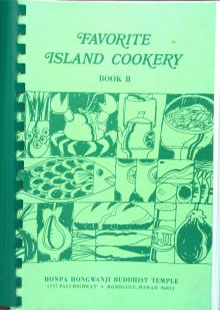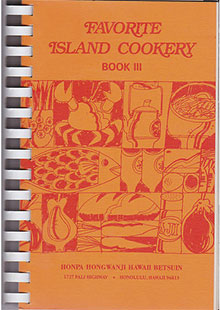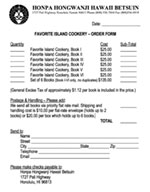Book I, 142 pages, published December, 1973

The first of a series of cookbooks compiled and published by members of the Honpa Hongwanji Hawaii Betsuin. Presents a selection of traditional Japanese, local and other ethnic favorite recipes contributed by members — over 260 recipes covering appetizers, soups, main dishes, sauces and dressings, picked vegetables, desserts, and adult beverages.
Book II, 236 pages, published December, 1975

Emphasizes recipes followed in preparation of important Buddhist observances, in particular, “shojin ryori,” and includes a greater selection of Japanese, local and other ethnic recipes.
Book III, 280 pages, published December, 1979
 Rejoices in the ethnic diversity found in Hawaii and typified in the culinary area. More than 460 recipes contain quick and easy-to-prepare dishes and island favorites from many lands. Also provides a comprehensive guide to Buddhist practices and, in particular, Hongwanji religious observances, together with a description and recipes for appropriate meals to be enjoyed.
Rejoices in the ethnic diversity found in Hawaii and typified in the culinary area. More than 460 recipes contain quick and easy-to-prepare dishes and island favorites from many lands. Also provides a comprehensive guide to Buddhist practices and, in particular, Hongwanji religious observances, together with a description and recipes for appropriate meals to be enjoyed.
Book IV, 181 pages, published December, 1985

In addition to providing a cumulative index for Books I through IV, with descriptive illustrations, focuses on the relationship between human nature and food, including Buddhist practices of showing reverence and gratitude for our daily sustenance.
Book V, 228 pages, published March, 1989

Emphasizes particular characteristics of culinary art contributed by immigrants from different prefectures or areas in Japan in celebration of Hawaii Betsuin’s centennial. Over 450 recipes, together with maps of Japan and Hawaii, are identified by country, prefecture, or city of origin.
Book VI, 205 pages, published December, 1995
 Provides more than 400 recipes of Asian and local favorites, focusing on unique nutritional characteristics of different food items to assist the user in making healthy choices each day. Includes tools for dietary planning, including recommended nutrient intake, dietary guidelines, the food pyramid, nutritional elements in readily available fruits and vegetables in Hawaii, and the way to understand food labels.
Provides more than 400 recipes of Asian and local favorites, focusing on unique nutritional characteristics of different food items to assist the user in making healthy choices each day. Includes tools for dietary planning, including recommended nutrient intake, dietary guidelines, the food pyramid, nutritional elements in readily available fruits and vegetables in Hawaii, and the way to understand food labels.


